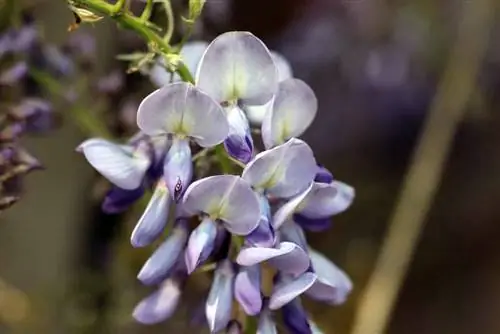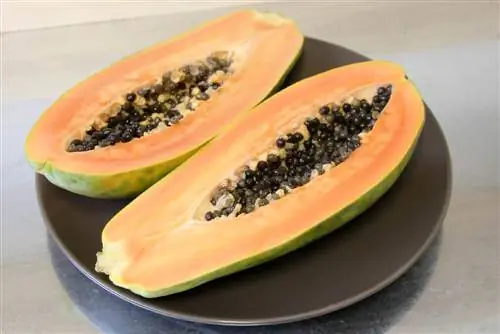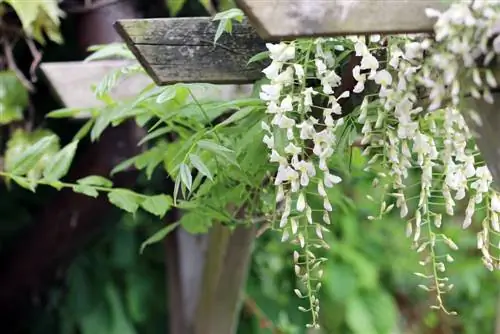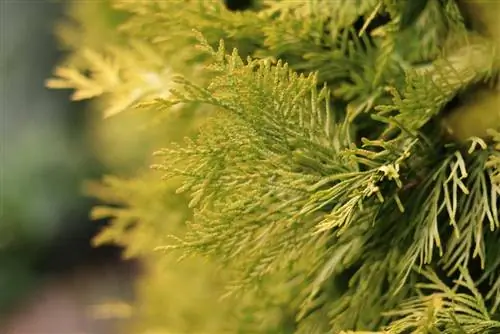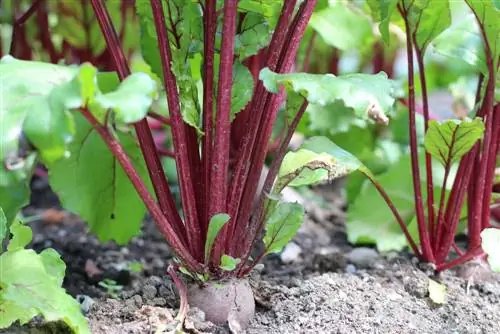- Author admin [email protected].
- Public 2023-12-17 03:39.
- Last modified 2025-01-24 12:45.
Climbing plants help transform bare house walls into green living spaces. Wisteria grows even more lushly than the well-known and widespread wild wine. In addition, it delights with lush flowers in bright blue tones, which makes it a very special eye-catcher. You can find out everything you need to know about the growth of this plant below.
General
Generally speaking, wisteria, also botanically known as wisteria, is considered a very lush and fast-growing plant. Since it is also an excellent climber, over time it can climb entire house walls, trellises or even garden sheds, garages, etc.let it disappear beneath itself. In measurable numbers this means:
- Growing quickly and very vigorously
- Increase in length per year approximately 1.00 to 1.50 meters
- Width growth per individual plant up to 4.00 meters and more
- Average maximum size around 10 to 12 meters
- Maximum size under optimal conditions but also up to 30 meters possible
Tip:
In addition to the pure dimension in length and width, you should also always keep its weight in mind when considering the size of the wisteria. A plant can quickly weigh several hundredweight when it is leafy, which of course also affects the aspects of growth described below.
Growth conditions and environment
In order to actually achieve the sizes described and, above all, to delight the gardener with the familiar blue sea of flowers, the wisteria should have the most favorable conditions possible:
The Location
Wisteria can also be found in other locations, but it only produces numerous flowers if these requirements for its growing location are well met:
- Full sunny
- ideally south side with deviations to the southeast or southwest possible, but also ensure that there is as little shading as possible
- Protected location, for example on the wall of the house, in the corner of the house, between the house and the garage, etc., as buds in particular are very susceptible to frost
- sufficient soil volume for the expected plant size, especially as a nutrient and water reservoir, but also for good anchoring of the plant in the subsoil
The planting distance
Because of its lush, almost rampant growth, individual wisteria should only be planted with sufficient distance between each other:
- Distance between individual plants at least 3 to 4 meters
- If necessary, plant with annual climbing plants up to the desired width growth
- If the planting is too dense, there will be mutual competition between the wisteria and mutual overgrowth, resulting in a very dense carpet of vegetation with reduced lighting options and lower flower output
The substrate
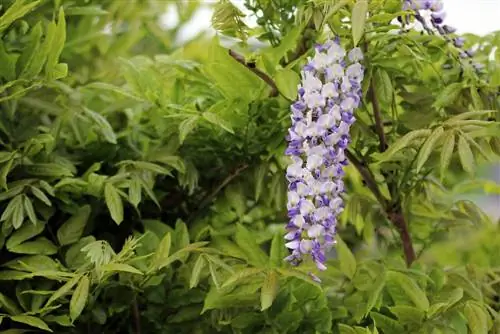
Wisteria places far fewer demands on the necessary substrate than its location and space. He attaches great importance to sufficient moisture without having to expect permanent waterlogging. Otherwise, it copes well with different soil conditions, although soils that are too compressed can hinder root growth and limit the increase in size by limiting the water absorption capacity. If new soil needs to be added, normal garden soil is usually sufficient, which can also easily be enriched with locally available soil material. However, special measures to improve the soil are hardly necessary.
The supply
Wisteria is very undemanding when it comes to care. It only needs water in increasing quantities as it grows larger. It should never dry out, especially in spring when the flowers are forming, as the dryness immediately affects the flowers. These are thrown off and the longed-for flower dream is gone for this season.
If the soil volume is small, the administration of universal fertilizers as a long-term substrate can also ensure the basic supply of nutrients during the growth period. Wisteria, on the other hand, does not have any special requirements for the supply of individual nutrients.
Tip:
If the wisteria is fertilized, the last application should be made at the end of summer at the latest. Otherwise, the plant, which is already very sensitive to its young shoots, can be stimulated to grow again too late in the year. As a result, the new shoots are still sufficiently mature before the first frosts occur and are therefore not hardy!
Trails
In contrast to the equally well-known wild vine, which is particularly impressive with its colorful autumn leaves, the wisteria initially requires some help when climbing walls or trellises. It does not have the well-known adhesive plates that usually remain unsightly after removing growth. Instead, the shoots wind around possible climbing aids, such as tension wires and wooden slats. Cracks and joints are also often used for a secure hold.
Tip:
Wisteria is often carelessly planted near rainwater downpipes or other pipes on the house wall. However, as it grows larger over time, it is easily capable of constricting and crushing a pipe. Therefore, these sensitive installations should be kept at a sufficient distance and, if necessary, regularly cleared of vegetation.
The Blossom
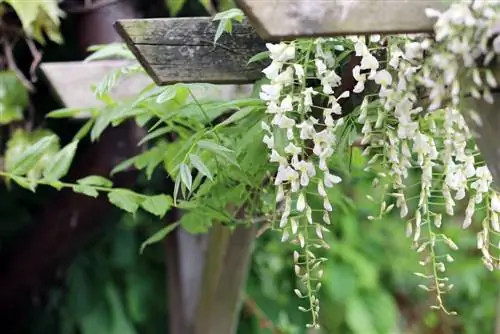
Finally, in addition to the general growth, two comments on the flowering of the wisteria are permitted here:
The onset of flowering
Although wisteria is considered uncomplicated and lush growing, it takes up to four years after planting to produce the familiar and desired flowers. If the general conditions are unfavorable, this time can even be extended.
Flower-forming shoots
Because of its lush growth, wisteria cannot be avoided by regular pruning. Sometimes an intermediate cut may even be necessary during the season. It is important to know that the plant produces its flowers on perennial wood. If you remove all new shoots completely, the wisteria will have to put its energy into new young shoots in the coming year. In addition, the perennial branches on which the flowers can grow are missing. Pruning should therefore be done in such a way that, in case of doubt, not all new shoots fall, but rather individual main shoots are removed right down to the old wood.

